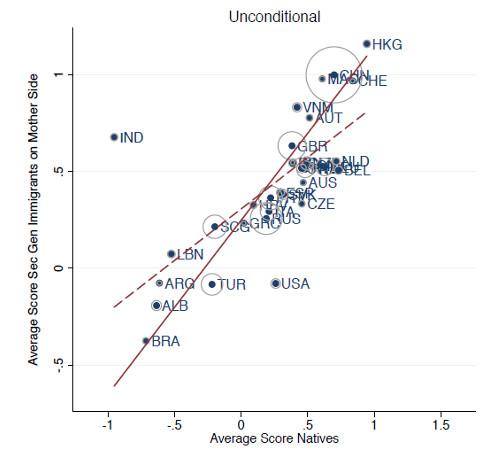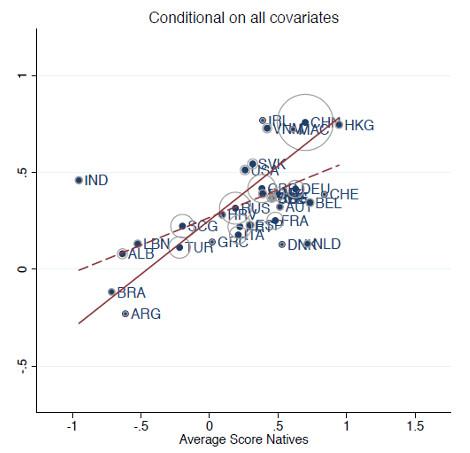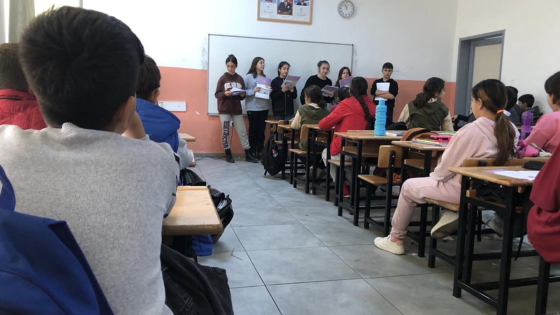Economists have largely investigated the role of human capital for cross-country gaps in economic performance (Barro 2001). A recent literature shows that not only differences in the quantity but also in the quality of human capital matter substantially (Schoellman 2012, Jones 2014, Lagakos et al. 2018), with a growing focus on standardised tests as measures of cognitive achievements. The evidence suggests that gaps in the average performance in standardised tests have large explanatory power for the cross-country variation in GDP per capita (Hanushek and Woessmann 2012). In light of this, it is crucial to understand where these gaps come from – whether from the quality of the school system or from other factors that vary at the country level – to effectively target policy interventions. For instance, a recent paper by Gneezy et al. (2019) shows that the amount of effort students exert in low-stakes exams, such as standardised international tests, varies greatly across countries, suggesting that these tests do not just capture children’s learning at school.
In a recent paper (De Philippis and Rossi 2020), we investigate the importance of parental influence, rather than differences in the quality of educational systems, for the cross-country variation in test scores. In particular, we consider not only the role of differences in parents’ observable characteristics, like socioeconomic status, but also in unobservable factors, like cultural traits and values.
Recent anecdotal and academic evidence shows that parental practices matter extensively for children’s academic achievements. Cobb-Clark et al. (2019) and Doepke and Zilibotti (2017) argue for instance that children’s human capital is shaped by parenting styles and parental attitudes towards education. Other papers investigate the role of specific cultural traits and values for students’ school performance. Figlio et al. (2019) find that performance depends greatly on parents’ long-term orientation, while Hanushek et al. (2020) emphasise patience and risk-taking. Parental cultural traits moreover seem to vary greatly across countries. For instance, the international bestseller by Amy Chua (2011) coined the expression ‘tiger mother’ to describe the attitude specific to demanding Asian mothers, who focus strongly on their children's academic excellence. Our paper assesses how much the variation in parental factors is also relevant for gaps in students’ achievements at the country level.
Using second-generation immigrants to assess the role of parental influence
To infer the importance for students’ performance of cross-country gaps in unobserved parental characteristics, like parenting style and cultural values, we propose an empirical strategy based on the analysis of second-generation immigrant students.
We argue that second-generation immigrants represent an interesting laboratory to study cross-country differences in parental influence. Students born and raised in the same country, educated in the same school and with parents with similar socioeconomic characteristics are subject to similar conditions in terms of the educational system and any other country-specific relevant factors. Still, part of any systematic difference across countries in parental practices and (unobservable) parental characteristics should be preserved across countries of origin of immigrant parents, and therefore be reflected in the educational performance of second-generation immigrants.
After having excluded concerns on endogenous selection into emigration, if unobserved parental factors are important drivers of cross-country differences in test performance, then we should expect second-generation immigrants from high-scoring countries to do better than those from low-scoring countries, even within the same host country and school.
Using both PISA and US Census data, we therefore relate the educational performance of second-generation immigrant students to the average PISA performance in their parents' country of origin, controlling for socio-economic status and for the characteristics of the school or educational system of the host country.
The top panel of Figure 1 displays the average score of second-generation immigrants against the average score of natives studying in the countries of origin of their mothers, pooled across all available waves. The relationship is positive and tight. While the cross-country variation in natives' performance reflects a combination of school quality, economic, cultural and institutional factors, the fact that these gaps are largely preserved across second-generation immigrant students in other countries suggests that parents play an important role. Of course, this pattern might be partially driven by factors unrelated to systematic differences in parental influence across countries. When we control for several potential confounders – absorbing differences in age, gender and family background, as well as comparing students educated in the same host countries and even in the same school (see the bottom panel of Figure 1) – the correlation weakens but is still positive and highly significant.
Figure 1 Performance of second-generation immigrants compared to their mother’s country of origin
Note: The top panel plots the average math PISA score of second-generation immigrants whose mother is from country m against the average math PISA score of natives in country m, for all countries with at least 100 second-generation immigrants on the mother's side in the sample. The bottom panel plots the predicted scores from a regression with individual math scores as dependent variable and controlling for fixed effects for the school attended in the host country, for students’ demographic characteristics, language used at home and family socio-economic status. The sample restricted to second-generation immigrants on the mother's side. The size of the circles is proportional to the number of second-generation immigrants on the sample. The solid (dashed) line shows the best weighted (unweighted) linear fit.
Source: PISA data.
We then quantify the importance of the parental component for cross-country gaps in test scores. Our results point towards a substantial role for parental characteristics, and in particular unobserved traits, which account for about 15% of the cross-country variation in test performance, roughly doubling the overall contribution of parental influence. The unobserved parental component is a key driver of the high performance of East Asian countries, as well as of the relatively low performance of Southern European countries. Overall, a narrow focus on observable socioeconomic characteristics substantially underestimates the importance of parents for cross-country gaps in human capital.
The importance of cultural traits as drivers of the substantial role of parents’ unobserved characteristics in cross-country gaps in test scores
When exploring potential mechanisms behind the estimated gaps in this parental unobservable component, we consider two broad interpretations of the parental country of origin effect. First, the outstanding performance of second-generation immigrants from high PISA countries might reflect the higher quality of the education received by parents in their country of origin (we call this the ‘intergenerational transmission of educational quality’ interpretation). Under this interpretation, our results would reinforce the rationale for policies aiming to replicate the schooling practices adopted in the most successful countries, since the benefit of doing so would extend to the following generations. The second mechanism we consider is that parents might transmit a set of values, preferences and beliefs regarding education that are typical of their country of origin's cultural context (we call this the ‘cultural’ interpretation). This variation in cultural traits might have its roots in factors deeply entrenched in a country's history and traditions, and improving the educational system might not do much to raise average test scores if these aspects do not change as well.
In our analysis, we do not find evidence in favour of the ‘intergenerational transmission of educational quality’ interpretation. On the contrary, the magnitude of the inferred unobserved component is greater for parents that acquired very little education in their home country (with no education or primary school education only) and were therefore less exposed to the home country's educational system.
On the other hand, our results support the importance of cultural factors, varying across countries and shaping parents' attitudes towards their children's education. First, we find that the unobserved parental component is weaker for parents who have spent more years in the host country, which is consistent with the importance of country-specific ‘cultural’ traits that are progressively lost by emigrants as they integrate in their new host country. Consistent with this interpretation, most of the variation in second-generation immigrants' performance is accounted for by differences across parental nationalities in proxies for cultural traits likely to be conducive to human capital investment, such as long-term orientation, locus of control and trust. These three cultural traits together explain about 13% of the cross-country variance in test scores. These magnitudes are comparable to the overall contribution of parental unobservables, giving further credence to the hypothesis that culture is an important driver of the cross-country variation in parental influence.
Implications for policy and future research
These results are relevant for policymakers aiming to raise the quality of human capital. We find that cross-country gaps go beyond differences in school quality and parents' socio-economic background – country-specific cultural values as well as parental practices matter substantially. This suggests that policies aimed at simply replicating school practices from highly performing countries might have smaller-than-expected effects.
Moreover, if parental attitudes are important determinants of human capital achievements, it is crucial to understand how they form and evolve, and why they do so differently across time and space. Some recent studies show that cultural values are very persistent over time and are transmitted across generations (e.g. Dohmen et al. 2008 and Giavazzi et al. 2014). Historical circumstances experienced in different countries (Roland and Yang 2017), as well as social interactions between people of various origins (brought about by migration or trade linkages), might have shaped the diffusion of different cultural traits, influencing parental practices and human capital accumulation across generations. Hopefully, future research will be able to shed more light on the working of this process and its implications for economic growth through a combination of case studies, historical data and theory.
References
Barro, J R (2001), "Human Capital and Growth," American Economic Review 91(2): 12-17.
Chua, A (2011), Battle Hymn of the Tiger Mother, The Penguin Press.
Cobb-Clark, D A, N Salamanca, and A Zhu (2019), “Parenting Style as an Investment in Human Development," Journal of Population Economics 32: 1315-52.
De Philippis, M, and F Rossi (forthcoming), “Parents, Schools and Human Capital Differences across Countries”, Journal of the European Economic Association.
Doepke, M, and F Zilibotti (2017), “Parenting With Style: Altruism and Paternalism in Intergenerational Preference Transmission," Econometrica 85: 1331-1371.
Dohmen, T, A Falk, D Huffman, and U Sunde (2008), “The intergenerational transmission of risk and trust attitudes”, VoxEU.org, 05 July.
Figlio, D, P Giuliano, U Ozek, and P Sapienza (2019), “Long-Term Orientation and Educational Performance”, American Economic Journal: Economic Policy, 11 (4), 272-309.
Francesco, G, I Petkov, and F Schiantarelli (2014), “Culture: Persistence and evolution”, VoxEU.org, 16 June.
Gneezy, U, J A List, J A Livingston, X Qin, S Sadoff, and Y Xu (2019), “Measuring Success in Education: The Role of Effort on the Test Itself,” American Economic Review: Insights 1(3): 291-308.
Hanushek, E A, and L Woessmann (2012), “Do Better Schools lead to More Growth? Cognitive Skills, Economic Outcomes, and Causation”, Journal of Economic Growth 17(4): 267-321.
Hanushek, E A, L Kinne, P Lergetporer, and L Woessmann (2020), “Culture and Student Achievement: The Intertwined Roles of Patience and Risk-Taking”, NBER Working Paper no. 27484.
Hanushek, E A, L Kinne, P Lergetporer, and L Woessmann (2020), “Patience, risk-taking, and international differences in student achievement”, VoxEU.org, 02 August.
Lagakos, D, B Moll, T Porzio, N Qian, and T Schoellman (2018), “Life-Cycle Human Capital Accumulation across Countries: Lessons from US Immigrants”, Journal of Human Capital 12(2): 305-342.
Roland, G, and D Yang (2017), “Cultural change and intergenerational transmission: Some lessons from China’s Cultural Revolution”, VoxEU.org, 05 August.
Schoellman, T (2012), “Education Quality and Development Accounting”, Review of Economic Studies 79(1): 388-417.





